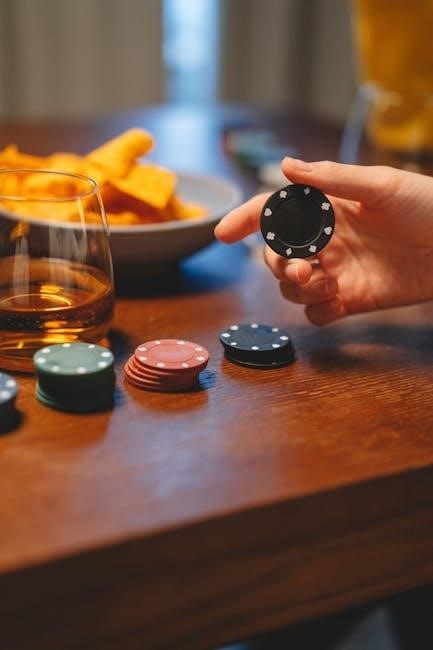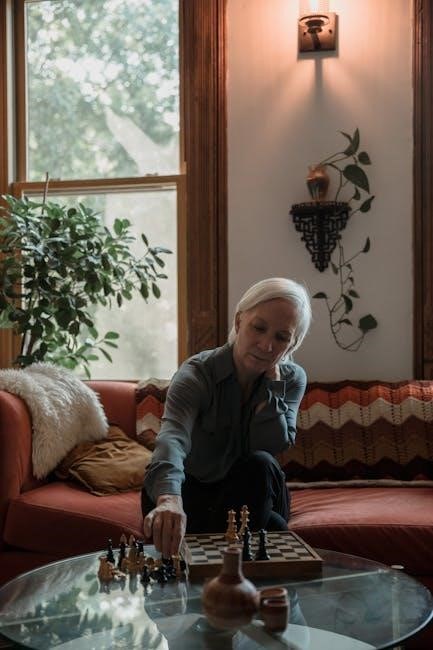The Old Maid card game is a classic and simple card game suitable for children and adults․ The main objective is to avoid being the player left with the unmatched “Old Maid” card at the end of the game․ The game involves matching pairs and strategically drawing cards from other players․
Objective of the Game
The primary objective of the Old Maid card game is remarkably straightforward: players aim to strategically discard all the cards they hold in their hands by forming matching pairs․ These pairs are typically based on the rank of the cards, such as two Queens, two Sevens, or two Aces, irrespective of their suit․ The core goal is to be the first to eliminate all cards from one’s hand through successful pairing and discarding․
However, intertwined with the discarding objective lies the critical element of avoiding a specific card, traditionally known as the “Old Maid․” This card is typically a single unmatched Queen or another pre-determined card that remains without a pair․ Players actively seek to avoid being left with this undesirable card when all other cards have been successfully matched and discarded by all participants․
Ultimately, the game culminates when all players, except one, have successfully paired and discarded all their cards․ The player left holding the single unmatched “Old Maid” card is declared the loser of the game․ Therefore, the strategic essence of Old Maid lies in skillfully managing one’s hand to both create pairs for discarding and avoid the unfortunate possession of the Old Maid card at the game’s conclusion․
Number of Players
The Old Maid card game is designed to accommodate a range of players, making it a versatile and engaging game for various group sizes․ The game is typically suitable for a minimum of two players, allowing for a head-to-head competition․ However, Old Maid truly shines when played with a larger group, accommodating up to six or even more players, depending on the specific deck and variations of the game being played․
With just two players, the game becomes a more strategic duel, where careful observation of the opponent’s discards and hand management becomes paramount․ As the number of players increases, the game introduces elements of chance and social interaction, as players must navigate a web of card exchanges and potential Old Maid transfers․

The ideal number of players for Old Maid often falls within the range of three to five individuals․ This provides a balanced dynamic, allowing for a mix of strategic decision-making and social engagement․ Regardless of the exact number, Old Maid remains an adaptable and enjoyable card game that can be tailored to fit the preferences and size of any gathering․
The Deck of Cards
The Old Maid card game utilizes a standard deck of 52 playing cards, with a slight modification to ensure the presence of the infamous “Old Maid” card․ Before gameplay commences, one of the Queen cards is removed from the deck․ Commonly, the Queen of Hearts is chosen for removal, but any Queen can be selected based on preference․
The removal of a single Queen leaves three remaining Queens in the deck, creating an unmatched card that serves as the “Old Maid․” This asymmetry is crucial to the game’s core mechanic, as players strive to avoid being stuck with this unwanted card at the game’s conclusion․
Alternatively, some variations of Old Maid introduce a Joker into the deck to act as the Old Maid card․ Other times, a card is removed from the pack at random․ Regardless of the method used to create the unmatched card, the remaining cards retain their standard suits (Hearts, Diamonds, Clubs, Spades) and ranks (Ace, 2-10, Jack, Queen, King), which will be used for pair-matching during the game․
Removing Pairs
At the commencement of the Old Maid card game, after the cards have been dealt, each player should immediately examine their hand for any pairs․ A pair consists of two cards with the same rank, regardless of their suit․ For instance, two 7s, two Kings, or two Aces would constitute valid pairs․ It’s important to note that only cards of the same rank can form a pair; cards of the same suit but different ranks do not qualify․
Once a player identifies pairs within their hand, they must discreetly remove these pairs and place them face down in front of them․ This action reduces the number of cards in their hand and brings them closer to the ultimate goal of the game: discarding all cards except, hopefully, the Old Maid․
In certain variations of the game, players might opt for a more challenging approach by only recognizing pairs that match in both rank and color․ For example, the 7 of Hearts and the 7 of Diamonds would form a valid pair, while the 7 of Hearts and the 7 of Clubs would not․ This adds a layer of complexity to the pair-matching process․
Dealing the Cards
The dealing process in Old Maid is crucial for setting up the game and ensuring fair play․ After removing a card (typically a Queen, to create the “Old Maid”), the dealer shuffles the remaining cards thoroughly to randomize their order․ This prevents any player from knowing the location of specific cards, especially the Old Maid, adding an element of chance to the game․
The dealer then proceeds to deal the cards face down, one at a time, to each player in a clockwise direction․ The distribution continues until all cards have been dealt․ It’s perfectly acceptable if some players end up with one more card than others; this is a normal occurrence and doesn’t affect the game’s outcome․
Once the dealing is complete, each player carefully picks up their cards and arranges them in their hand, concealing them from the other players․ Players should then examine their hands for any initial pairs, which are immediately discarded face down, setting the stage for the core gameplay to commence․
Gameplay: Drawing Cards
The core gameplay of Old Maid revolves around players drawing cards from each other, attempting to create pairs and discard them․ Beginning with the player to the dealer’s left, the gameplay proceeds in a clockwise direction․ On their turn, a player offers their hand, face down, to the player on their left; This player must then randomly select one card from the offered hand․

After selecting a card, the drawing player adds it to their hand and examines their cards for any new pairs․ If a pair is formed (two cards of the same rank), the player discards the pair face down․ If no pair is formed, the player keeps the drawn card, and their turn ends․ The play then passes to the next player on the left, who repeats the process of offering their hand and having a card drawn․
This cycle of drawing and discarding continues around the table․ The anticipation builds as players strategically try to avoid being left with the Old Maid card while simultaneously trying to pair off their other cards․ The element of chance inherent in the card draws adds to the excitement of the game․

Passing Cards to the Left
The act of passing cards to the left is the central mechanic that drives the Old Maid game forward, creating both the challenge and the suspense․ After a player has drawn a card from their neighbor and checked for pairs, if no pair was made, the player must hold onto the card and wait for their turn․ When the player to their right takes their turn, the player must offer their entire hand, face down, to that player․ The player to their right will then choose one card at random to add to their own hand․

This process of passing cards to the left continues around the table, with each player in turn offering their hand to their neighbor․ The random nature of the card selection ensures that no player knows which card they will receive, adding an element of uncertainty to each draw․ This uncertainty is what keeps the game interesting, as players try to deduce which cards their opponents might be holding and strategically attempt to avoid receiving the Old Maid card․
This constant exchange of cards is what allows players to create pairs to discard and contributes to the shifting fortunes of the game․
Discarding Pairs During Play
Throughout the gameplay of Old Maid, the discarding of pairs is a crucial action that allows players to reduce the number of cards they hold and move closer to the goal of emptying their hand․ After drawing a card from the player to their right, a player should immediately check their hand to see if any pairs can be formed․ A pair consists of two cards of the same rank, such as two Queens, two Sevens, or two Aces․ The suits of the cards do not matter when forming a pair․
If a player finds one or more pairs in their hand, they should discard them face up into a discard pile․ The discard pile should be kept separate from the draw pile and should be easily visible to all players․ It is important to discard pairs as soon as they are formed, as this reduces the risk of being stuck with the Old Maid card․ In the event that a player has three of a kind, they only discard two of the cards to avoid revealing too much information about their hand to the other players․
Discarding pairs is a continuous process throughout the game․
Game End
The Old Maid card game concludes when all players, except one, have successfully discarded all the cards in their hands by forming and laying down pairs․ As players continue to draw and discard, the number of cards in each player’s hand gradually decreases․ The game progresses with each player taking their turn to draw from the player to their left and discarding any newly formed pairs․
The moment arrives when only one player remains with cards in their hand․ This signifies that all other players have managed to get rid of all their cards by matching pairs․ The player left with cards cannot form any more pairs with the remaining cards in their possession․ This situation marks the end of the gameplay․
The player left holding the final unmatched card, which is invariably the “Old Maid” card (typically a Queen), is declared the loser of the game․ All other players are considered winners, having successfully avoided being stuck with the Old Maid․
Identifying the Loser (Old Maid)
The culmination of the Old Maid card game arrives when only one player is left holding one or more cards, signaling the end of the matching and discarding process․ This remaining player is then identified as the loser of the game, often referred to as the “Old Maid․” The defining factor in identifying the loser is the presence of the unique “Old Maid” card in their final hand․
The “Old Maid” card is typically a Queen, although variations can exist where a Joker or any designated card serves this purpose; The key characteristic is that this card cannot be paired with any other card in the deck, making it the unwanted card that players strive to avoid․
Once all possible pairs have been discarded and a single player remains with the “Old Maid” card, that player is declared the loser․ All other players who have successfully discarded their cards are considered winners, having skillfully avoided being left with the unlucky card․
Variations in Removing the Old Maid Card
While the standard version of Old Maid often involves removing a Queen, several variations exist regarding which card is designated as the “Old Maid” and removed from the deck before gameplay begins․ These variations add an element of surprise and can cater to different player preferences․ One common variation involves using a Joker as the “Old Maid” card․ This adds a whimsical element to the game, as the Joker is already a unique card in the deck․
Another variation involves randomly removing a card from the deck without revealing it․ This creates uncertainty, as players are unaware of which card is the “Old Maid” until the very end․ This variation increases the suspense and adds a layer of strategic guessing to the gameplay․
Some variations even involve removing a specific card based on a pre-determined rule, such as removing the Queen of Hearts or the lowest-ranking card in a particular suit․ These variations can add complexity and require players to adapt their strategies accordingly․
